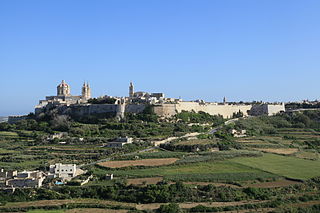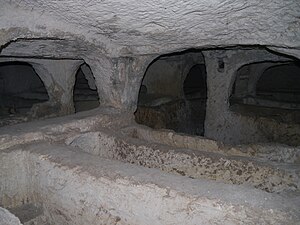
Catacombs are human-made underground passages primarily used for religious purposes, particularly for burial. Any chamber used as a burial place is considered a catacomb, although the word is most commonly associated with the Roman Empire.

The Catacombs of Rome are ancient catacombs, underground burial places in and around Rome, of which there are at least forty, some rediscovered only in recent decades.

Rabat is a town in the Northern Region of Malta, with a population of 11,497 as of March 2014. It adjoins the ancient capital city of Mdina, and a north-western area formed part of the Roman city of Melite until its medieval retrenchment.

Mdina, also known by its Italian epithets Città Vecchia and Città Notabile, is a fortified city in the Northern Region of Malta which served as the island's former capital, from antiquity to the medieval period. The city is still confined within its walls, and has a population of 250, but it is contiguous with the town of Rabat, which takes its name from the Arabic word for suburb, and has a population of over 11,000.

A hypogeum or hypogaeum is an underground temple or tomb.

Tal-Barrani is a primarily agricultural area in Malta that extends from the town of Żejtun to the villages of Santa Luċija, Ħal Tarxien and Ħal Għaxaq, lying across many south-eastern communities in Malta. The land gives its name to a nearby chapel dedicated to Saint Lucy. In a notarial document dating from the 16th century, the area near this estate was known as bitalbarrani, that is, the stranger's or outsider's land. This name may indicate that the land under cultivation at Tal-Barrani belonged to some outsider, either someone from outside a village community, or a foreigner. Moreover, the same land contained another area which was called Tal-Misilmin .[A] At least from the 17th century onwards, Tal-Barrani was a recognised agricultural estate, and was documented in the 1654 property book of the Order of St. John, the Cabreo Magisteriale.

Antonio Annetto Caruana, also known as A. A. Caruana, was a Maltese archaeologist and author.

The Lamta Archaeological Museum is an archaeological museum located in Lamta, Tunisia.

The Abbatija Tad-Dejr hypogeal complex is a paleochristian burial site in Rabat, Malta.

San Pawl Milqi are the ruins of a Roman period agricultural villa and pagan temple, the largest ever discovered in Malta. A Christian church was built on the site based on the Biblical mention of the shipwreck of Saint Paul on the island. In the place of the current chapel there was a temple dedicated to the Greek god Apollo and a Roman villa. According to religious tradition, the villa is where Saint Publius, Governor and first Bishop of Malta, received Saint Paul after his shipwreck.

The Tal-Mintna Catacombs are a hypogea complex in Mqabba, Malta. The complex dates to at least to the fourth century AD.

The Salina Catacombs are a cluster of small catacombs located near the Church of the Annunciation in Salina, Naxxar, in Malta. Although small when compared to the catacombs of St. Paul and St. Agatha in Rabat, they are an important record of the sizeable community that must have lived in the area in around the last half of the first millennium AD.

There are hundreds of catacombs in Malta, principally found in Mdina, the former capital of the island. The catacombs are very small, but are in good preservation.

The fortifications of Mdina are a series of defensive walls which surround Mdina, the former capital city of Malta from antiquity to the medieval period. The city was founded as Maleth by the Phoenicians in around the 8th century BC, and it later became part of the Roman Empire under the name Melite. The ancient city was surrounded by walls, but very few remains of these have survived.

Ta' Ċieda Tower, also known as San Ġwann Roman Tower, is a Punic-Roman tower in San Ġwann, Malta. The exact origins of the tower could date back to pre-history with different architecture. It is argued that the tower could be of Punic origins rather than Roman but the latter have adapted it. The site of the tower was used as a cemetery, or more, during the Muslim caliphate in the medieval times. Following the expulsion of the Muslims in Malta a church dedicated to St. Helen was built on the site.

Mdina Gate, also known as the Main Gate or the Vilhena Gate, is the main gate into the fortified city of Mdina, Malta. It was built in the Baroque style in 1724 to designs of Charles François de Mondion, during the magistracy of Grand Master António Manoel de Vilhena.

Melite or Melita (Latin) was an ancient city located on the site of present-day Mdina and Rabat, Malta. It started out as a Bronze Age settlement, which developed into a city called Ann under the Phoenicians and became the administrative centre of the island. The city fell to the Roman Republic in 218 BC, and it remained part of the Roman and later the Byzantine Empire until 870 AD, when it was captured and destroyed by the Aghlabids. The city was then rebuilt and renamed Medina, giving rise to the present name Mdina. It remained Malta's capital city until 1530.
The Temple of Apollo was a Roman temple in the city of Melite, in modern Mdina, Malta. It was dedicated to Apollo, the god of the sun and music. The temple was built in the 2nd century AD, and it overlooked a semi-circular theatre. The temple's ruins were discovered in the 18th century, and many architectural fragments were dispersed among private collections or reworked into new sculptures. Parts of the temple's crepidoma still exist, having been rediscovered in 2002.

The Għar Għerduf catacombs at Ta' Kerċem, also known as Għar Gerduf, are the only surviving early Christian catacombs or paleochristian hypogea in Gozo, Malta. Għar Għerduf is a unique Roman burial site in Gozo, which has for centuries attracted the attention of scholars interested in Maltese archaeology. The site was visited by erudite visitors who often included a description of the place as they did for Ġgantija and the Xagħra Stone Circle.
The Ħal Resqun catacombs at Gudja, are interpreted as early Christian catacombs or paleochristian hypogea in Malta. The Ħal Resqun catacombs are especially notable for their carved decorations, and other features which are uncommon in Maltese catacombs, and of exceptional value. Some historians have suggested that, unlike other catacombs, those at Ħal Resqun portray enough Christian markers to be classified as paleochristian remains, while others view these features to be inconclusive. Some of the graffiti, interpreted by a number of historians as portraying a biblical scene, are thought to be unique in the world, and considered one of the most important remains from Late Antiquity in Malta.




















